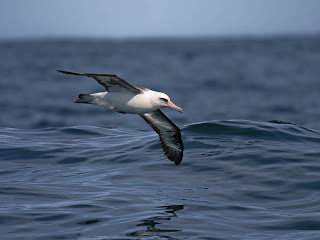 |
| This photo is one of a series by Sharon Toochin of an apparent first photographically documented record of Solander's Petrel in North America. Photo used with permission. Click photo for larger view. |
The status of Solander's Petrel, also known as Providence Petrel,
Pterodroma solanderi, is an enigma off the Pacific coast of North America. At-sea identification of fly-by out-of-range birds is difficult, as these birds are very similar to Murphy's Petrels. Both of these birds of open ocean are dark birds about the size of a small Sooty Shearwater. These petrels are generally not attracted to vessels or chum, are solitary wanderers, and fly in fast bounding flight.
The first North American report of Solander's Petrel was by experienced seabird researcher R.L. Pitman (Bailey 1989). He spotted 4 dark
Pterodroma 55-70 miles off Oregon on 20 May 1981. He identified them as Solander's Petrels. His cruise continued into California waters, where he found many more dark petrels. These, however, he identified as Murphy's Petrels. Both sightings would have been North American firsts.
The very next month, on 15 June 1981, a beach-cast specimen of Murphy's Petrel was found near Newport, Oregon. Subsequently, through the 1980's, a couple more Murphy's Petrels washed up on Oregon's shores, and California birders discovered that Murphy's Petrels were the most common spring seabird more than 50 miles off California. Pitman's identification as Solander's Petrel was not generally accepted.
Since that time, Murphy's Petrel records continued to increase. Murphy's Petrels were removed from the California Review list, with over 100 accepted records. Oregon has 6 accepted records of Murphy's Petrel, 3 beach-cast specimens and 3 photographed birds. There are an additional 8 other Oregon sight reports of a total of 71 birds. [See
Rare Seabirds of Oregon.]
Many of these reports of Murphy's Petrels come from seabird researcher Michael Force during marine mammal and seabird surveys in 1994 and 1997. On 18 April 1994 Force reported 21 Murphy's Petrels and 1 Solander's Petrel about 180 miles off Waldport, Oregon. Again, on 12 May 1997 Force recorded 2 Murphy's Petrels and 2 Solander's Petrels 140 miles off Florence, Oregon.
There are two additional reports of Solander's Petrels off the West Coast, bringing the total to 5 reports. A bird was photographed 173 miles off Cape Mendocino, California on 8 August 2005. But this bird was apparently not accepted by the California Records Committee. A sight record came from off Westport, Washington, on 11 September 1983.
So, 5 previous reports of Solander's Petrels, with no accepted verifiable objective evidence, brings us to the most recent set of photographs.
"On Tuesday October 06 2009 four birders (Mike and Sharon Toochin, Roger Foxall and Arti Ahier) observed and photographed this dark Pterodroma. This sighting occurred approximately 28nm west of Tofino, BC over Clayoquot Canyon at a sea depth of approximately 3000 feet. The bird was identified as a Murphy’s Petrel at sea. Upon examination of the photographs at home, Mike questioned the possibility of this being a Solander’s Petrel. Because we have no actual experience with Solander’s and limited first hand experience with Murphy’s we had the photos looked at by experts who have had first hand experience with both species. The consensus thus far is that this bird is a Solander’s Petrel." - Sharon Toochin
The field marks of Murphy's and Solander's Petrels are not well shown in Harrison's 1983
Seabirds: an identification guide (too dark brown, inaccurate tail shape). Murphy's Petrel is shown fairly well in
The Sibley Guide to Birds, 2000. Murphy's is dark gray, the bill is short and small, there is more white on the chin than above the bill, and the tail is rounded. There is a variable light-dependant flash on the under flight feathers.
The first thing that stands out on the bird photographed above (click photo for larger view), is that the bill is long and heavy. The bases of the primaries are white, the tips of the greater primary coverts are dark and bases light. These form a white patch divided by a dark bar between the primaries and the greater primary coverts. There is more white on the face above the bill than on the chin. The tail appears to be longer and pointed.
This looks like a good "first" North American record!


















